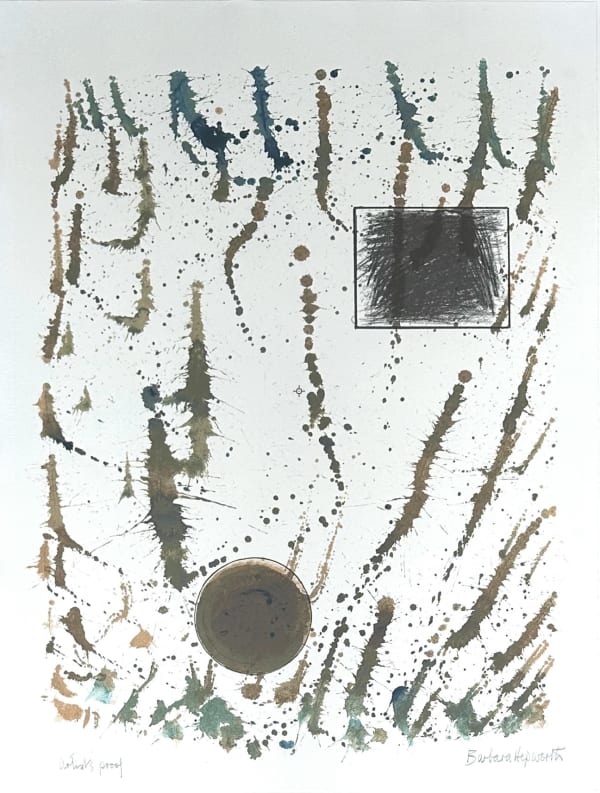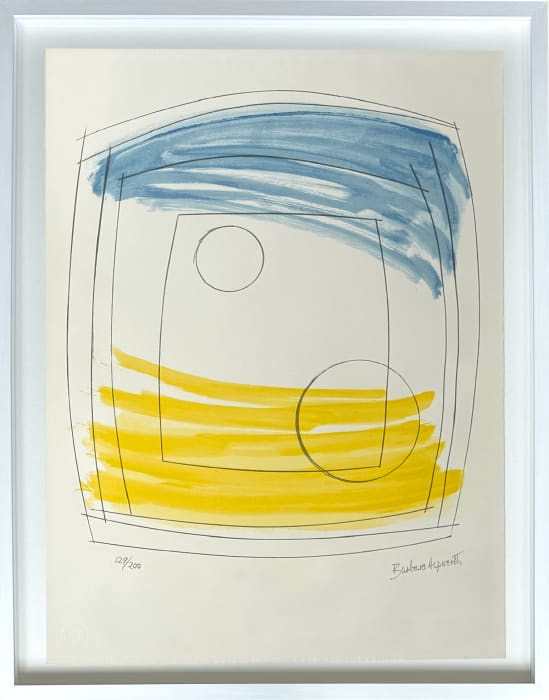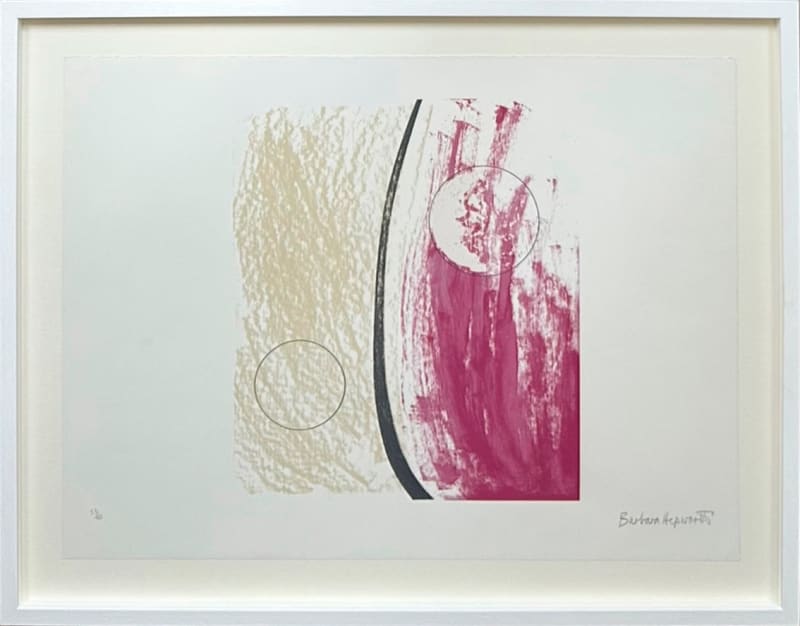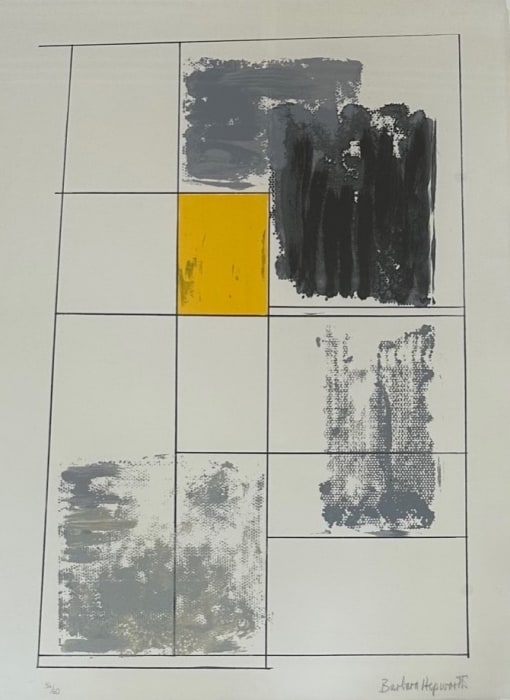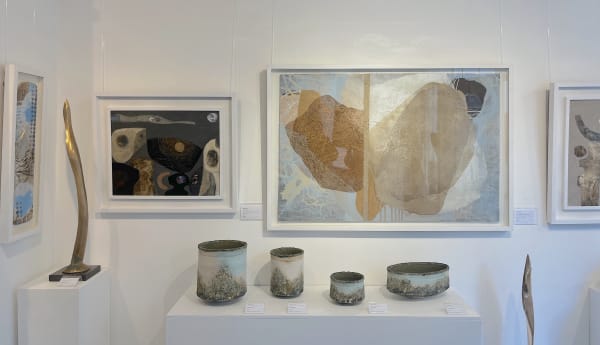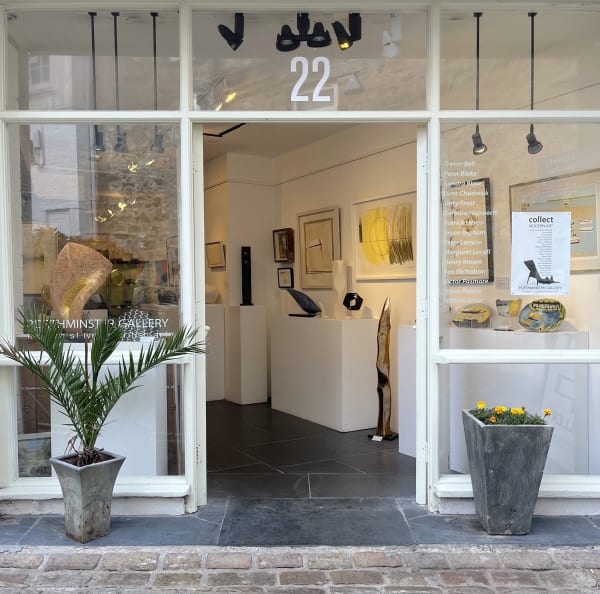Barbara Hepworth DBE English, 1903-1975
Barbara Hepworth, Ben Nicholson and their children went to live in Cornwall at the outbreak of the Second World War in 1939.
Hepworth lived in Trewyn Studios in St Ives from 1949 until her death in 1975. Trewyn Studios had once been an outbuilding of Trewyn House, later purchased by her pupil and assistant John Milne in 1956. She said that "Finding Trewyn Studio was sort of magic. Here was a studio, a yard, and garden where I could work in open air and space." St Ives had become a refuge for many artists during the war. On 8 February 1949, Hepworth and Nicholson co-founded the Penwith Society of Arts at the Castle Inn; 19 artists were founding members, including Peter Lanyon and Bernard Leach.
Hepworth was also a skilled draughtsperson. After her daughter Sarah was hospitalised in 1944, she struck up a close friendship with the surgeon Norman Capener. At Capener's invitation, she was invited to view surgical procedures and, between 1947 and 1949, she produced nearly 80 drawings of operating rooms in chalk, ink, and pencil. Hepworth was fascinated by the similarities between surgeons and artists, stating: "There is, it seems to me, a close affinity between the work and approach of both physicians and surgeons, and painters and sculptors."
In 1950, works by Hepworth were exhibited in the British Pavilion at the XXV Venice Biennale alongside works by Matthew Smith and John Constable. The 1950 Biennale was the last time that contemporary British artists were exhibited alongside artists from the past. Two early public commissions, Contrapunctal Forms and Turning Forms, were exhibited at the Festival of Britain in 1951.
During this period, Hepworth and Nicholson divorced (1951). Hepworth moved away from working only in stone or wood and began to work with bronze and clay. Hepworth often used her garden in St Ives, which she designed with her friend the composer Priaulx Rainier, to view her large-scale bronzes.
Barbara Hepworth was a British sculptor, who was born in Wakefield, Yorkshire in 1903. She was a leading figure in the international art scene throughout a career spanning five decades.
Hepworth studied at Leeds school of Art from 1920-1921 alongside fellow Yorkshire-born artist Henry Moore. Both students continued their studies in sculpture at the Royal College of Art in London. Both became leading practitioners of the avant-garde method of Direct Carving (working directly in to the chosen material) avoiding the more traditional process of making preparatory models and maquettes from which a craftsman would produce the finished work.
From 1924 Hepworth spent two years in Italy, and in 1925 married her first husband, the artist John Skeaping, in Florence; their marriage was to last until 1931.
From 1932, she lived with the painter Ben Nicholson and, for a number of years, the two artists made work in close proximity to each other, developing a way of working that was almost like a collaboration. They spent periods of time travelling throughout Europe, and it was here that Hepworth met Georges Braque and Piet Mondrian, and visited the studios of Picasso, Constantin Brancusi, and Jean Arp and Sophie Taueber-Arp. The experience was a hugely exciting one for Hepworth, for she not only found herself in the studios of some of Europe's most influential artists, which helped her to approach her own career with renewed vigour and clarity, but also found there mutual respect. The School of Paris had a lasting effect on both Hepworth and Nicholson as they became key figures in an international network of abstract artists.
By now married and with triplets as well as a son from her first marriage, when war broke out in 1939, Hepworth and Nicholson moved to St Ives. Though she didn’t know it, the seaside town would remain her home for their rest of her life, and after the war she and Nicholson became a hub for a generation of younger emerging British artists such as Peter Lanyon, Roger Hilton and Terry Frost – who was Hepworth’s studio assistant for a time. As she had found, the wild beauty of the surrounding terrain offered a counter to the disruption and destruction of the war. And, like her, those artists made paintings and sculptures inspired by the place and the forces and their experience of nature.
Though concerned with form and abstraction, Hepworth’s art was primarily about relationships: not merely between two forms presented side-by-side, but between the human figure and the landscape, colour and texture, and most importantly between people at an individual and social level.
Hepworth is known first and foremost as a sculptor, but she also worked in other mediums – and was very interested in documenting her own work through photography. The landscape around St Ives became part of the way her works were presented in the media; St Ives Bay, Godrevy Lighthouse and The Island all become compositional tools for those documenting her works, creating an additional dialogue between the forms and their surroundings.
From 1947–49, during an illness her daughter suffered, Hepworth produced a series of drawings and paintings based on her time observing doctors and surgeons at St Mary’s hospital in Exeter.
Barbara Hepworth’s name is still intertwined with the history and culture of St Ives and her studio and sculpture Garden remain one of the town’s most popular destinations. In the town where Hepworth was born, as well as housing a rich archive of the artist’s work and serving as a platform for contemporary artists working today, The Hepworth Wakefield also pays lasting homage to an artist who spoke frequently of the effect her surroundings had on her formative years.
In her lifetime, however, she was also a major international figure, showing her work in exhibitions around the globe. As a woman in a largely male-dominated art-world, Hepworth took an active role in the way her work was presented. She was particular about documentation of her works, and collaborated closely with others. She established innovative ways to push the boundaries of her technique and thematic investigations and sustained a career that saw her mount a retrospective at Kröller-Müller Museum in 1965, represent Britain at the Venice Biennale in 1950 and won first prize at the São Paulo Bienal in 1959.
-

WHERE ROCKS BECOME SEA | Autumn–Winter Show
4 Nov 2023 - 6 Jan 2024Gallery show of contemporary art for sale, featuring new paintings by artists Sara Dudman, Masako Tobita, and ceramics by Peter Hayes, Charlotte Jones, Mitch Pilkington, Antonia Salmon, Paul Wearing, and prints by Melvyn Evans and Trevor Price, and sculptures by Tommy Rowe and Michael Thacker. With supporting works by leading 20th Century modern artists: Terry Frost, Barbara Hepworth, Victor Pasmore and Joe Tilson. Artworks also available for sale by St Ives and British Artists: Wilhelmina BARNS-GRAHAM, Peter BLAKE, Sandra BLOW, Patrick CAULFIELD, Lynn CHADWICK, Maurice COCKRILL, Terry FROST, Barbara HEPWORTH, Patrick HERON, David HOCKNEY, Bryan INGHAM, Albert IRVIN, Margaret LOVELL, Henry MOORE, Ben NICHOLSON, Victor PASMORE, Bryan PEARCE, Tommy ROWE, William SCOTT, Joe TILSON.Read more -

COLLECT | MODERN ART
9 Sep - 4 Nov 2023Gallery exhibition of Modern St Ives and British art for sale, featuring art – paintings, prints, drawings, and sculptures – by leading 20th Century artists, including: Wilhelmina BARNS-GRAHAM, Peter BLAKE, Sandra BLOW, Patrick CAULFIELD, Lynn CHADWICK, Maurice COCKRILL, Terry FROST, Barbara HEPWORTH, Patrick HERON, David HOCKNEY, Bryan INGHAM, Albert IRVIN, Margaret LOVELL, Henry MOORE, Ben NICHOLSON, Victor PASMORE, Bryan PEARCE, Tommy ROWE, William SCOTT, Joe TILSON.Read more -

BARBARA HEPWORTH
signed prints from the 1970s 18 Feb - 18 Mar 2023As one of the leading British artists of her generation, Barbara Hepworth was the first woman sculptor to achieve international recognition. From 1939 she was based in St Ives, where,...Read more -

COLLECT: MODERN ART
Exhibition of original art by leading 20th Century St Ives & British Artists 12 Mar - 30 Apr 2021Our annual selling exhibition of original art by leading 20th Century St Ives and British Artists, provides exciting opportunities for new and seasoned collectors alike. With the boost in growth...Read more -

Collect | Modern St Ives + British Art
21 May - 25 Jun 2016A specially curated selling exhibition of collectable artworks by major St Ives and British names. The exhibition will also feature new sculptures by Margaret Lovell and Peter Hayes, and paintings...Read more

